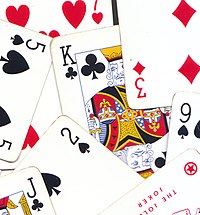
Back Baralla anglesa Catalan Baraja inglesa Spanish Karta ingeles Basque Peruskorttipakka Finnish Стандартна колода Ukrainian

The standard 52-card deck[citation needed] of French-suited playing cards is the most common pack of playing cards used today. The main feature of most playing card decks that empower their use in diverse games and other activities is their double-sided design, where one side, usually bearing a colourful or complex pattern, is exactly identical on all playing cards, thus ensuring the anonymity and fungibility of the cards when their value is to be kept secret, and a second side, that, when apparent, is unique to every individual card in a deck, usually bearing a suit as well as a alphanumerical value, which may be used to distinguish the card in game mechanics. In English-speaking countries it is the only traditional pack[a] used for playing cards; in many countries, however, it is used alongside other traditional, often older, standard packs with different suit systems such as those with German-, Italian-, Spanish- or Swiss suits. The most common pattern of French-suited cards worldwide and the only one commonly available in English-speaking countries is the English pattern pack. The second most common is the Belgian-Genoese pattern, designed in France, but whose use spread to Spain, Italy, the Ottoman Empire, the Balkans and much of North Africa and the Middle East.[1] In addition to those, there are other major international and regional patterns including standard 52-card packs, for example, in Italy that use Italian-suited cards. In other regions, such as Spain and Switzerland, the traditional standard pack comprises 36, 40 or 48 cards.
Cite error: There are <ref group=lower-alpha> tags or {{efn}} templates on this page, but the references will not show without a {{reflist|group=lower-alpha}} template or {{notelist}} template (see the help page).
- ^ Pattern Sheet 80 at i-p-c-s.org. Retrieved 23 August 2020.